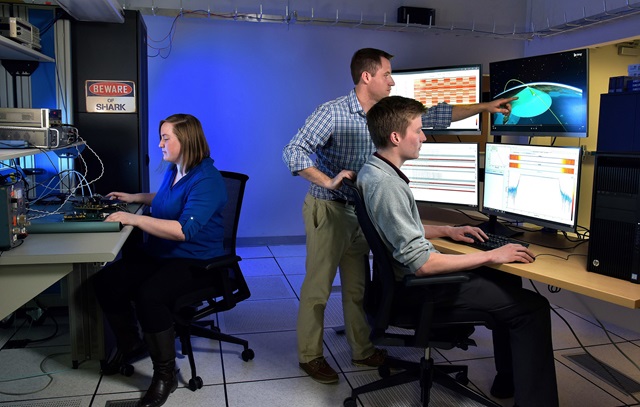Jeff Hobbs, Dave Schiller, Nick Durland and Caroline Traini
Sharks are always swimming — even into open, potentially treacherous, waters — because it’s the only way to avoid sinking.
In June 2018, recognizing our customers’ growing focus on speed and rapid deployment, we realized we had to be like sharks: sink or swim. We chose to swim, and move into the unknown by pioneering a first-of-its-kind payload, along the way reinventing everything from how we approach challenges to the technology itself.
Going from mission conception to delivering a space payload can take years — sometimes a decade or more — but we only had a little over two years and a small lab of team members, many of them fresh out of college.
Together, we developed SharkSat, an on-orbit technology demonstration hosted aboard Northrop Grumman’s Cygnus spacecraft. In January, after completing a three-month stay at the International Space Station, SharkSat spent two weeks orbiting the Earth and transmitting valuable telemetry data and performance information back to mission controllers.

SharkSat is a stepping-stone toward reusing on-board equipment for multiple applications on future missions. In this case, the telemetry data provided insight into the health and functioning of the electronic components of SharkSat.
But, to us, our early-career team is the real investment of SharkSat.
Looking at the collection of resumes, it may not have seemed clear how our new SharkSat team would be successful at this trailblazing task — many didn’t have on-the-job experience — but they brought maximum energy, diverse perspectives and a wealth of knowledge.
This was intentional: in addition to building an innovative payload, our goal was to build a pipeline of technical talent. By creating an opportunity for early-career employees to gain exposure to space and earn a war story of their own, we’re developing the next generation of space leaders.
In our newly constructed laboratory — situated in a former computer server room — our fresh-faced team made critical decisions, from determining the most beneficial technology to test on orbit (knowing, if successful, it could be applied on future missions) to designing the hardware/software package that ultimately performed the technology demonstration.
Our approach was to put a premium on achieving quality while taking calculated risks, testing thoroughly while not over-testing and, above all, tight collaboration. Namely, if someone needed help…SCREAM!
On launch day, the team gathered by Zoom — with some team members making the hours-long drive to NASA’s Wallops Flight Facility on the Eastern Shore of Virginia — to watch the launch and celebrate what they had achieved. That’s when it really sank in for all of us. Watching Antares launch with Cygnus and our SharkSat Payload on board we all thought, “Our team touched that and now it’s up there.”
It wasn’t a sure bet that we would make our launch window (which we did), that SharkSat would power on once in space (which it has) or that, after the demonstration, we would have reams of information to study for potential use on future missions (which we are).
Along the way, our team learned many lessons — about flexibility, agility, open-mindedness and hard work — but, most of all, team members learned that they’re capable of great success, encouraging them to swim confidently forward to the next challenge.
Return to Life at Northrop Grumman home page.